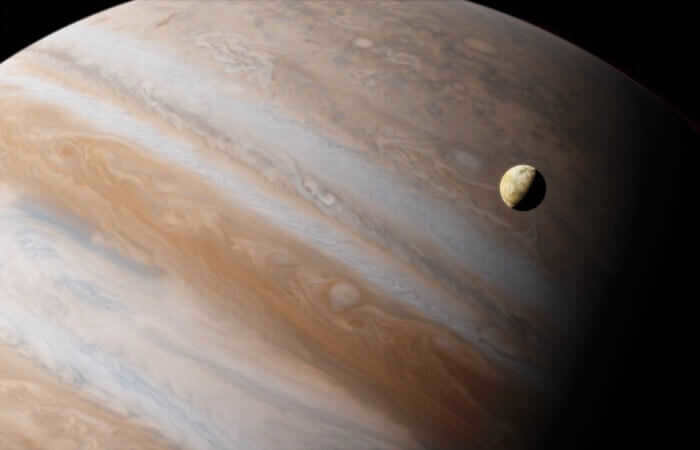
Jupiter is the largest planet in our solar system and is the fifth planet from the Sun. It belongs to the category of gas giants.
Overview of Jupiter:
Jupiter – the largest planet in our solar system and the fifth farthest planet from the Sun. It falls into the group of gas giants, just like Saturn, Uranus, and Neptune.
The name Jupiter is derived from the ancient Roman god of thunder.
Jupiter has been a familiar sight to humans for thousands of years. References to Jupiter can be found as far back as the 8th and 7th centuries BC. However, it was only 400 years ago that people truly became captivated by the planet, when they were able to observe its swirling clouds, the Great Red Spot, and its numerous satellites through the first telescopes.
During periods of great opposition, Jupiter can be easily seen in the night sky as one of the brightest objects (ranking third in brightness after the Moon and Venus). Jupiter’s disk and satellites are highly popular among amateur astronomers.
The average distance between Jupiter and the Sun is approximately 778.57 million kilometers (or 5.2 astronomical units). The distance between Jupiter and Earth can range from 588 to 967 million kilometers. Jupiter takes about 11.8 Earth years, or 4,332.589 Earth days, to complete one orbit around the Sun.
The magnitude of the planet is astonishing. When it comes to mass, radius, volume, and surface area, Jupiter takes the lead as the largest planet in our solar system. Jupiter’s mass is 1.8981-10 27 kg, equivalent to 317.8 Earth masses. In fact, Jupiter is 2.47 times more massive than all the other planets in our solar system combined. With a radius of 69,911 ± 6 km, Jupiter is 11 times larger than Earth in terms of diameter (and radius). However, despite its enormous size, Jupiter’s average density is only 1.326 g/cm 3, which is less than a quarter of Earth’s density.
The acceleration due to gravity on Jupiter is 24.79 m/s², while on Earth it is 9.81 m/s2. Furthermore, the escape velocity on Jupiter is 59.5 km/s, compared to Earth’s 11.186 km/s.
There are various atmospheric phenomena on Jupiter, such as lightning, storms, and auroras, which surpass those on Earth. Jupiter is home to the largest storm in the solar system, known as the Great Red Spot. This colossal storm is capable of engulfing three Earths and has been active for an astonishing 350 years. It currently measures between 15,000 and 30,000 kilometers in size. Additionally, Jupiter showcases vibrant and enduring auroras around both of its poles.
Jupiter boasts a total of 79 satellites, with some of the largest ones being Io, Ganymede, Europa, and Callisto. These satellites were initially discovered by Galileo Galilei in 1610 using a telescope. Interestingly, Jupiter’s satellites rotate in different directions. The satellites whose names end with the letter “e” (such as Karme, Sinope, Ananke, Pasiphae, and others) orbit the planet in a retrograde direction, which means they move in the opposite direction to Jupiter’s rotation. Furthermore, Jupiter has three faint rings – the main ring, the “spider’s web” ring, and the halo.
Astronomical properties of Jupiter:
Jupiter is one of the five prominent planets that can be seen without the need for a telescope. When viewed from Earth during opposition, Jupiter can have an apparent magnitude of -2.94m, making it the third brightest object in the night sky after the Moon and Venus. The apparent magnitude of Jupiter decreases as its distance from Earth increases, with the maximum distance resulting in an apparent magnitude of -1.61m.
The distance between Jupiter and Earth ranges from 588 to 967 million kilometers. On average, Jupiter is about 778.57 million km (or 5.2 a.u.) away from the Sun. Due to Jupiter’s orbit eccentricity of 0.048775, there is a difference of 76 million km in distance between perihelion and aphelion. At perihelion, Jupiter is approximately 740,573,600 km (or 5.204267 a.u.) from the Sun, while at aphelion it is about 816,520,800 km (or 0.728 a.u.) away. The inclination of Jupiter’s orbit to the ecliptic plane is 1.304°. The planet’s average orbital velocity is 13 km/s.
Jupiter rotates in the same direction as all the other planets in the Solar System, except for Venus and Uranus.
When observing Earth from space, the movement of Jupiter appears to be extremely slow. It takes Jupiter 11.8 Earth years (or 4332.589 Earth days) to complete one orbit around the sun. Additionally, Jupiter has the shortest day of any planet, as it completes one full rotation on its axis in just 9 hours and 55 minutes. This rapid rotation causes the poles of Jupiter to flatten and the equatorial line to expand.
Unlike Earth, Jupiter’s equatorial plane is very close to the plane of its orbit, with an inclination of only 3.13° compared to Earth’s 23.45°. As a result, Jupiter does not experience changing seasons like we do on Earth.
Characteristics of Jupiter’s physical structure and orbit:
| Physical characteristics of Jupiter | |
| Surface area | 6.22-10 10 km² |
| Macca | 1.89-10 27 kg |
| Volume | 1.43-10 15 km³ |
| Average density | 1.33 g/cm³ |
| Polar compression | 0,06487 |
| Polar radius | 66,854 km |
| Equatorial radius | 71,492 km |
| Average radius | 69,911 km |
| Equatorial rotation speed | 45,300 km/h |
| First space velocity | 42.58 km/s |
| Second space velocity | 59.5 km/s |
| Free-fall acceleration at the equator | 24.79 m/s² |
| Axis tilt | 3,13° |
| Rotation period | 9.925 hours |
| Declination of the north pole | 64,496° |
| North Pole direct ascent | 17 h 52 min 14 c |
Jupiter’s magnetic field consists of a dipole component, as well as higher-order harmonics such as quadrupole, octupole, and others. It is believed that Jupiter’s magnetic field is generated by a dynamo mechanism similar to that of Earth. However, unlike our planet, Jupiter’s conductor of currents is a layer of metallic helium.
The tilt of Jupiter’s magnetic field axis in relation to its rotational axis is approximately 10.2 ± 0.6°, which is similar to Earth. The north magnetic pole is located near the north geographic pole, while the south magnetic pole is close to the south geographic pole. At the cloud surface level, the field strength is approximately 1.1 nTL at the north pole and 0.9 nTL at the south pole. The polarity of Jupiter’s magnetic field is opposite to that of Earth.
The magnetic field of Jupiter has a flattened shape, resembling a disk, which sets it apart from the Earth’s drop-shaped magnetic field. This unique shape is a result of the centrifugal force exerted on the rotating plasma and the thermal pressure of the glowing plasma. These forces cause the magnetic field lines to stretch, forming a thin, pancake-like structure known as a magnetodisc. This structure is particularly pronounced at a distance of 20 RJ (where RJ represents the radius of Jupiter) and exhibits a thin current structure near the magnetic equator.
Jupiter is surrounded by a magnetosphere, an area where the behavior of plasma and charged particles is determined by its magnetic field. These particles come from two sources: the solar wind and the moon Io. When Io’s volcanoes erupt, the ash they release gets ionized by the sun’s ultraviolet light, creating sulfur and oxygen ions. While some of these particles escape Io’s atmosphere, others remain in orbit around the moon, forming a torus that lies in the same plane as Jupiter’s equator.
The torus plays a crucial role in shaping the dynamics of Jupiter’s magnetosphere. The pressure from the magnetic field counteracts the incoming solar wind at a distance of 50 to 100 times the radius of Jupiter. Without the influence of Io, this distance would be limited to a maximum of 42 times the radius of Jupiter (42 RJ).
Jupiter possesses formidable radiation belts. The electron energy is immense, approximately 20 MeV, and radiation levels are 25 times the lethal dose for humans.
Jupiter’s atmospheric composition, natural conditions, and temperature:
Jupiter has an atmosphere composed of two primary elements: hydrogen (approximately 89.8 ± 2%) and helium (10.2 ± 2%). Traces of methane, water vapor, silicon, ammonia, and benzene are also detected. Smaller quantities of hydrogen sulfide, carbon, neon, ethane, oxygen, sulfur, and phosphine are also present.
The following layers are distinguished within Jupiter’s atmosphere:
Jupiter does not possess a mesosphere and the corresponding mesopause.
In the upper layers, the thermosphere experiences high temperatures, reaching around 1000 K. As one descends deeper into the planet towards the tropopause, there is a rise in pressure and a decrease in temperature (down to 110 K). Beyond the tropopause, both pressure and temperature begin to increase in tandem as we delve further inward. The hydrogen-helium atmosphere seamlessly transitions into the liquid hydrogen mantle, a bubbling sea of liquid hydrogen with no clearly defined lower boundary.
Various fascinating phenomena occur within the thermosphere. It is here that Jupiter sheds most of its heat through radiation, resulting in polar lights and the formation of the ionosphere.
On Jupiter’s north and south poles, auroras can be observed, which are much more intense than on Earth and almost never cease. This phenomenon is caused by the strong radiation, magnetic field, and volcanic emissions from Jupiter’s moon Io.
Jupiter’s atmospheric pressure ranges from 20 to 220 kilopascals. The average temperature of Jupiter cannot be determined due to the absence of a solid surface.
The weather conditions on Jupiter are also remarkable. The winds can reach speeds of up to 620 kilometers per hour. Within a matter of hours, these winds can generate a massive storm that spans thousands of kilometers in diameter. The Great Red Spot was first spotted on Jupiter in the 1600s and continues to exist today, albeit it is gradually diminishing in size.
The convective currents responsible for transporting internal heat to the surface of Jupiter are classified as light zones and dark bands. The light zones, characterized by higher pressures, are associated with upward flows. Situated approximately 20 km above, the clouds in these zones exhibit a light color, which is believed to be linked to a high concentration of bright white ammonia crystals. In contrast, the dark clouds found below are composed of red-brown ammonium hydrosulfide crystals and have higher temperatures. These dark clouds, also known as belts, represent areas of downward flow. The zones and belts exhibit varying velocities in alignment with Jupiter’s rotation. The boundaries between the zones and belts are marked by intense turbulence, giving rise to various vortex structures, including the famous Great Red Spot of Jupiter.
Unlike Earth, where the surface temperature drops, in certain parts of Jupiter that are shaded by its large satellites, the temperature actually rises.
Composition and Surface of Jupiter:
Jupiter, the largest of the gas giants in the solar system, does not have a distinct boundary between its atmosphere and the rest of its interior.
Scientists propose that Jupiter is made up of an atmosphere, a layer of helium-liquid metallic hydrogen, and a rocky core. The metallic hydrogen layer is estimated to be 42-46 thousand kilometers thick and has a temperature exceeding 9,700 o C. The core is believed to have a mass and size equivalent to 10 Earth masses.
There is a belief that the core’s mass is equivalent to 10 Earth masses, and its size is 1.5 times its diameter. The core of the planet is heated to a temperature of 35,000 degrees Celsius, which surpasses the Sun’s temperature. Nevertheless, the precise arrangement of Jupiter’s inner regions and its chemical constitution cannot be ascertained through contemporary observational techniques.

Jupiter, the largest planet in our solar system, has a diameter of approximately 143,000 km and orbits around the Sun at an average distance of 778 million km. What makes Jupiter truly fascinating is its remarkably low average density of 1.33 g/cm³, in stark contrast to Earth’s density of 5.52 g/cm³. This discrepancy in density and mass clearly indicates that Jupiter’s composition and structure are vastly different from those of Earth and the other inner planets. In fact, extensive studies of Jupiter’s atmosphere and interior have confirmed these differences.
Unlike Earth and the other terrestrial planets, Jupiter doesn’t have a solid surface. Instead, the transition from a gaseous atmosphere to a liquid interior occurs gradually at tremendous depths.
The precise age of Jupiter remains a mystery currently. The challenge lies in the fact that scientists have yet to ascertain Jupiter’s formation process. According to a hypothesis, Jupiter, along with other planets, emerged from a solar nebula approximately 4.6 billion years ago, but this is merely speculative.
Cloud formations and a massive crimson spot observed on the celestial body of Jupiter
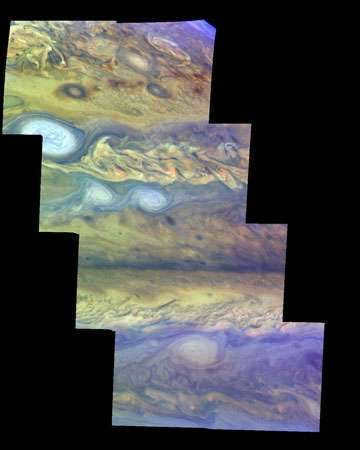
A color mosaic depicting a portion of Jupiter’s northern hemisphere is captured by the Galileo spacecraft on April 3, 1997. The top of the image represents the north. Distinctive characteristics include alternating cloud bands in the east and west, white ovals, dark spots, and turbulent whirlpools. This particular image is among the earliest to reveal the various layers of Jupiter’s atmosphere: the haze above the clouds in the upper atmosphere appears dark purple, the high thin clouds are blue, the high and dense clouds appear white, while the clouds below exhibit reddish hues within the atmosphere.
Even a small telescope can provide a wealth of information about Jupiter. The portion of Jupiter’s atmosphere that can be seen from Earth is home to various types of clouds, which are arranged both vertically and horizontally. While these cloud systems can change over the course of a few hours, the overall pattern of latitudinal currents remains consistent for decades. Jupiter’s appearance is characterized by alternating dark bands known as belts and bright bands known as zones. The major currents on the planet are relatively stable, although there have been instances where the southern equatorial belt has vanished (most recently in 2010), only to reappear months or even years later.
The Characteristics of the Great Red Spot
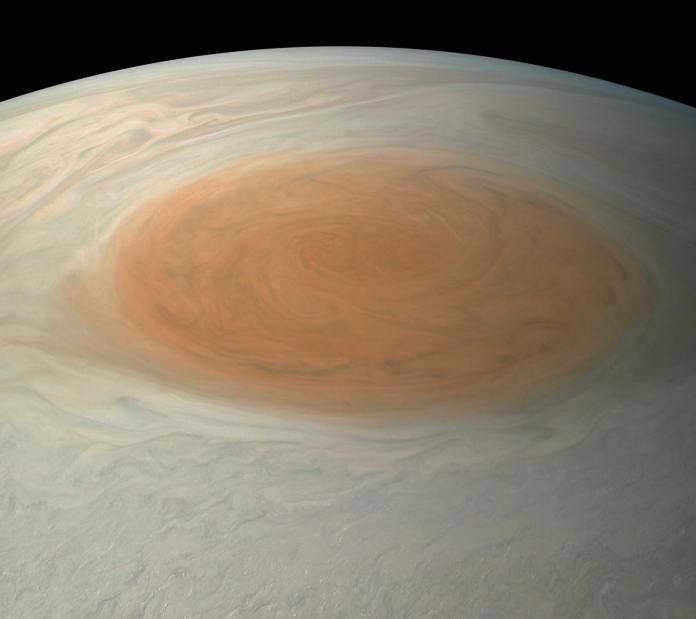
A color image of Jupiter’s Great Red Spot taken by the Juno spacecraft.
Despite extensive observations from the Voyager, Galileo, and Juno spacecraft, the true nature of Jupiter’s famous red spot remained unknown as the 21st century began. While clouds on Jupiter typically last only a few days, the Great Red Spot has been continuously observed since 1878 and may even be the same storm that was observed from 1665 to 1713. The spot, which measures approximately 48,000 km at its maximum length, experienced a decrease in size during the late 19th century. Since 2012, it has become more rounded and is shrinking at an accelerated rate of 900 km per year. Currently, its diameter is about 16,350 km, making it large enough to fit Earth inside.
Structure of the Clouds on Jupiter
The clouds on Jupiter are formed at varying altitudes within the planet’s atmosphere. The uppermost clouds consist of frozen ammonia crystals and have a pale white appearance. These clouds have temperatures around -150 °C and bear a resemblance to the frosty, blue water clouds found in Earth’s atmosphere. On the other hand, the lower-level clouds are scattered across the planet and display a reddish hue. These clouds form at approximately -70°C, indicating that they are made up of condensed ammonium hydrosulfide. The coloration of these clouds may be attributed to the presence of other compounds such as ammonia and sulfur, including ammonium polysulfides. Sulfur compounds are considered to be potential colorants due to their relatively high abundance in outer space.
Motion
Jupiter is not only characterized by its immense size, but it also possesses a unique atmosphere composed of 90% hydrogen and 10% helium. Due to its status as a gas giant, there is no clear separation between the atmosphere and the rest of the planet. As one descends towards the center, the temperature and density of the hydrogen and helium change, resulting in the division of Jupiter’s atmosphere into four distinct parts:
Given the absence of a solid surface on Jupiter, it is customary in the field of science to define the lower atmospheric limit as the point where the pressure reaches one bar. As altitude decreases, the temperature of the atmosphere also decreases, eventually reaching a minimum. The troposphere and stratosphere of Jupiter are demarcated by the tropopause, which sits 50 kilometers above the so-called “surface” of the planet.
The visible parallel stripes of Jupiter are made up of ammonia clouds, according to scientists. These stripes are known as the poles (dark bands) and the zones (light bands), and they alternate with each other. Interestingly, only the dark bands are composed entirely of ammonia, while the substance responsible for the lighter tone has yet to be identified.
Describing the time on Jupiter can only be done in superlatives, just like everything else on this planet. Its surface is dominated by a massive storm that never stops, constantly changing shape and capable of expanding to thousands of kilometers in just a few hours. The winds on Jupiter blow at speeds of over 350 kilometers per hour.
Jupiter is home to the most magnificent storm in the entire universe, known as the Great Red Spot. This awe-inspiring storm has been raging for hundreds of Earth years without any signs of stopping. With winds reaching a staggering speed of 432 kilometers per hour, it is a force to be reckoned with. The sheer size of the storm is mind-boggling, as it could easily accommodate three Earths within its colossal expanse.
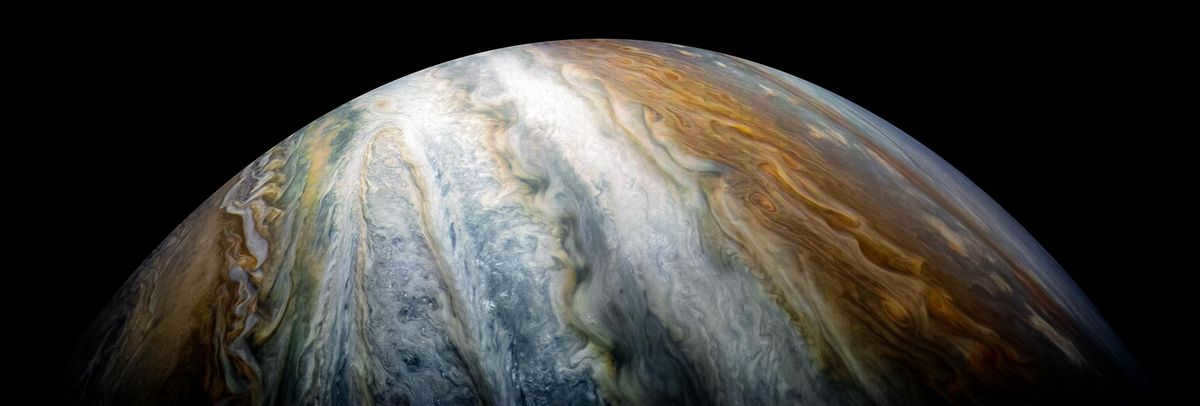
The duration of Jupiter’s orbital revolution
Jupiter completes one revolution around the Sun in a period of 4331 days, resulting in a velocity of 13 kilometers per second. The planet’s orbit is inclined at an angle of 6 degrees relative to the Sun’s equator, and due to its immense size, it exerts a gravitational force on the star that extends beyond its surface.
Due to its minimal axial tilt of only 3.13 degrees, Jupiter does not experience any significant changes in seasons.
Terrain
Jupiter’s terrain is often misunderstood. The gaseous atmosphere, composed mainly of hydrogen and helium, seamlessly transitions into a vast layer known as the mantle. This mantle is an immense expanse of metallic hydrogen, resembling an ocean in its properties and behavior. Extending to a depth of approximately 45,000 km, the mantle is then succeeded by the core. The core of Jupiter is remarkably dense, weighing tens of times more than Earth and possessing temperatures several times hotter than the Sun.
The Galileo spacecraft had instruments that allowed it to not only measure the composition of Jupiter’s atmosphere, but also the temperature and pressure as it made its descent. The figure displayed provides a profile of these measurements, along with the locations of different cloud layers if they were present where expected. It should be noted that temperatures exceeding the freezing point of water (0 °C) have been recorded at pressures significantly higher than those found at sea level on Earth (approximately one bar). This can be attributed mainly to the internal energy source of Jupiter, although some warming may also occur due to the atmosphere’s ability to trap infrared radiation, similar to Earth’s greenhouse effect.
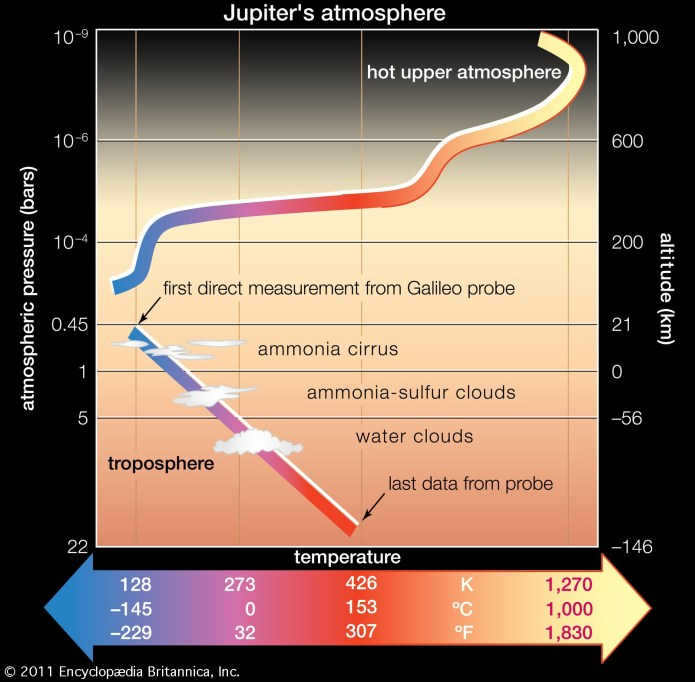
Profile of Jupiter’s atmosphere derived from accelerometer data and direct measurements taken by the Galileo spacecraft. The reference altitude is established at one bar (equivalent to sea level pressure on Earth). The clouds depicted in the chart indicate the estimated positions of the anticipated cloud layers (refer to the accompanying text for more details).
The temperature increase observed above the tropopause (highlighted as the uppermost point in the diagram) is referred to as an inversion, as temperatures typically decline with increasing altitude. This inversion phenomenon is a result of the absorption of solar energy at these altitudes by gases and aerosol particles. A similar temperature reversal occurs in Earth’s atmosphere due to the presence of ozone.
Research
During the period of 1972-74, Jupiter was visited by two Pioneer spacecraft. These spacecraft were able to make observations of the planet itself, as well as its asteroid belt. They also recorded data on the planet’s radiation and its powerful magnetic field. This data led scientists to hypothesize that there may be liquid inside Jupiter capable of conducting an electric current. Additionally, the second Pioneer spacecraft caused scientists to suspect that Jupiter has rings.
In 1977, the Voyager spacecraft were launched and it took them two years to reach Jupiter. Once there, they sent back to Earth the first stunning images of the planet. These images confirmed the presence of rings around Jupiter. Furthermore, the Voyager spacecraft allowed scientists to confirm the idea that the atmospheric processes on Jupiter are much more intense and spectacular than those on Earth.
In 1989, the Galileo spacecraft embarked on a journey to explore the planet. However, it was not until 1995 that it successfully deployed a massive probe, which commenced the collection of crucial data regarding the star’s atmosphere. Subsequently, scientists have been able to sustain ongoing, systematic investigations of this colossal entity with the invaluable assistance of the orbiting Hubble telescope.
Due to the immense radiation emitted by the gas giant, spacecraft are hesitant to approach it closely, as such proximity may result in the malfunctioning of their onboard electronics.
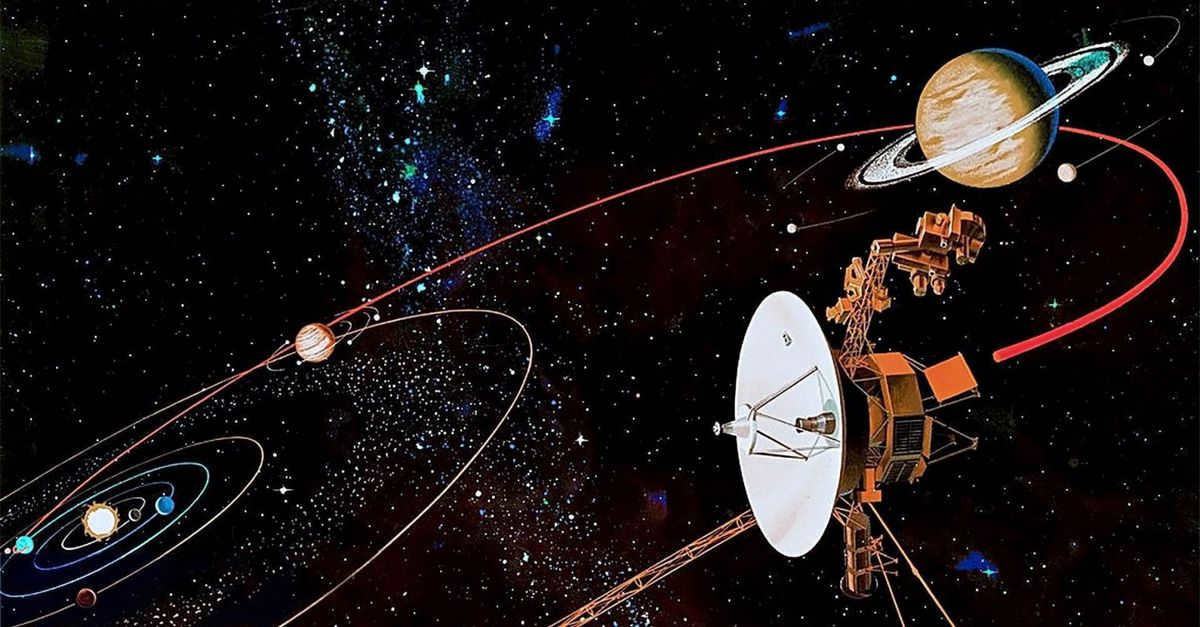
Moons and Ring of Jupiter
The four brightest moons of Jupiter, also known as the Galilean moons, were the first objects in the solar system to be discovered using a telescope by Galileo in 1610. In 1892, Edward Emerson Barnard discovered Jupiter’s fifth known moon, Amalthea, through visual observation. Subsequently, all other known satellites have been identified through photographs or electronic images taken by telescopes on Earth or by the cameras of the Voyager spacecraft. The multi-component ring of Jupiter was also revealed through images captured by the Voyager spacecraft in 1979.
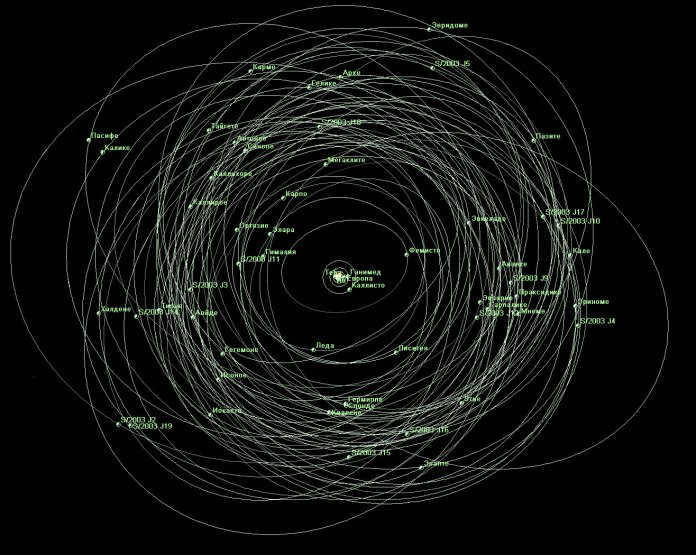
Jupiter’s Composition and Atmospheric Structure
It is hypothesized that Jupiter is comprised of a central core composed of rocky materials and various molten metals.
Surrounding the core is a layer of metallic hydrogen, which is then followed by a mixture of helium and molecular hydrogen.
In terms of temperature, the upper atmosphere of Jupiter reaches a chilling minus 145 degrees Celsius, while the core can reach scorching temperatures of up to 35,700 degrees Celsius.
Why is the existing data considered inaccurate? Scientists have yet to obtain precise measurements, but based on gravitational observations, it is highly likely that Jupiter lacks a solid core. Instead, the planet’s surface is thought to consist of ice and water droplets. Above this layer, there are clouds composed of ammonium crystals, followed by frozen ammonia.
As such, Jupiter, like other gas giants, does not possess a solid surface.
As time passed, the atmosphere continued to evolve.
At the highest layer, known as the thermosphere, hydrogen dominates.
In the stratosphere layer, helium makes up about 10% of the composition, while the remaining majority consists of hydrogen.
Moving closer to the planet’s center, the troposphere contains a combination of hydrogen, ammonium hydrosulfite, water, ammonia, and helium, with the gaseous state transitioning to a liquid state at altitudes of 900 – 1000 km. The upper clouds of ammonia can be observed on the surface of Jupiter.
Upon observing the planet’s surface, distinct bands of varying colors become apparent. These differences are caused by the presence of sulfur, carbon, ammonia, and phosphorus compounds.
Jupiter is experiencing some incredibly fascinating processes in its atmosphere. It is constantly plagued by storms, accompanied by thunder and lightning. The lightning strikes on Jupiter can reach lengths of over a thousand kilometers. The planet is also known for its whirlwinds, which manifest as cyclones and anticyclones, with wind speeds exceeding 600 kilometers per hour. Interestingly, the wind at the equator moves in the same direction as the planet’s rotation, while at the poles, it moves in the opposite direction.
One of the most well-known vortexes on Jupiter is the Great Red Spot, which is so large that it could easily accommodate three Earth-sized planets. Just imagine the sheer scale of the entire planet!
Jupiter still holds many mysteries, and one of them is the presence of hotspots, primarily located in the equatorial belt and spanning tens of thousands of kilometers in size. Although they appear circular in shape, they are not classified as whirlpools.
Jupiter is also surrounded by a magnetosphere. Its magnetic field is shaped like a flattened disk and is tilted about 10 degrees compared to its axis of rotation.
The radiation belts generated by this magnetic field are nearly forty thousand times stronger than those of Earth.
Similar to Earth, Jupiter also displays auroras at its poles, although they are constantly present here.
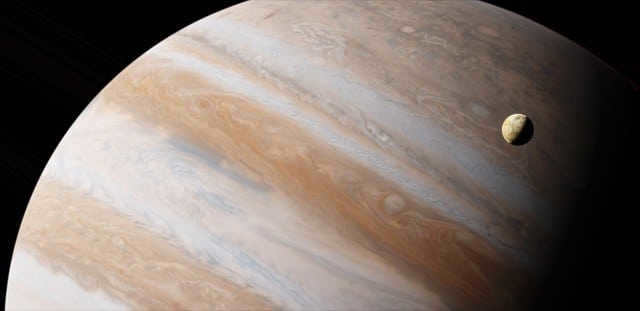
The planet Jupiter and its moon, Io
Recent updates
It will require several years to thoroughly examine the data, however, certain details, such as the stunningly exquisite new high-definition images of Jupiter, are currently accessible and can be observed on this webpage.
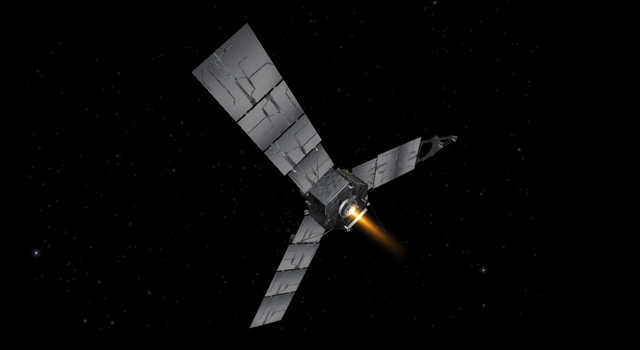
Juno is currently collecting data on the atmosphere, structure, and magnetosphere of Jupiter
The upcoming mission to investigate Jupiter and its moons is the Jupiter Icy Moon Explorer (JUICE). The primary objective of the JUICE mission is to study Ganymede, a moon believed to have a substantial amount of water and potentially capable of supporting life. The preparatory stages for the JUICE mission are almost finished, and it is expected to arrive at Jupiter in October 2029.
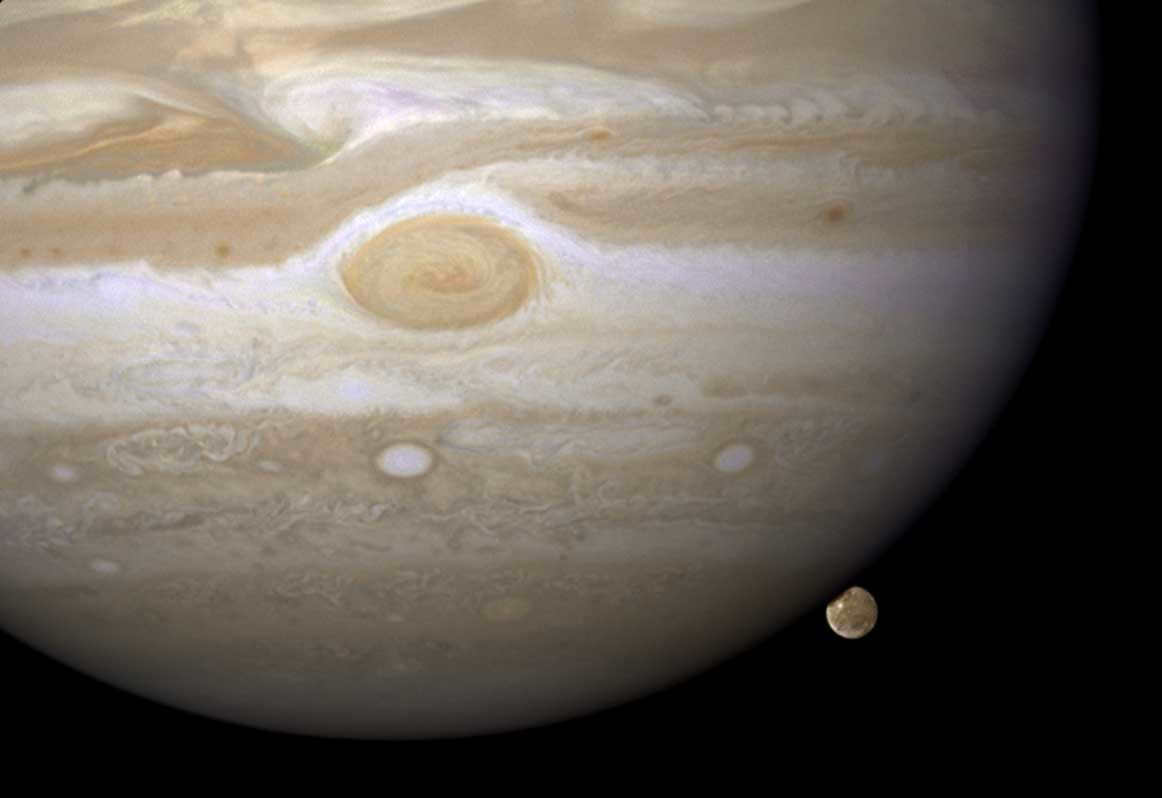
Size, mass, and orbit
The planet’s size, mass, and orbit are truly unique. It boasts a staggering mass of 1.8981 x 1027 kg, a voluminous 1.43128 x 1015 km3, and a surface area spanning 6.1419 x 1010 km2. Its average circumference stretches an impressive 4.39264 x 105 km. To put it into perspective, this planet is 11 times larger in diameter than our own and a whopping 2.5 times more massive than all the other planets in the solar system combined.
Distance between Jupiter and the Sun
The distance from the Sun to the planet Jupiter is much greater than the distance from the Sun to Earth. While Earth’s distance from the Sun is approximately 150 million kilometers or 1 astronomical unit, Jupiter’s average distance is 778 million kilometers, which is equivalent to 5.2 astronomical units. Although Jupiter’s orbit is not perfectly circular, the difference in distance between its closest and farthest points from the Sun is only 76 million kilometers.
A year on Jupiter is equivalent to 11.86 Earth years, which is the time it takes for Jupiter to complete one revolution around the Sun. Every 13 months, Jupiter and Earth align, resulting in the minimum distance between them. This alignment, known as opposition, provides the best opportunity to observe Jupiter.
Every 13 years, a rare event called the Great opposition of Jupiter occurs. During this time, Jupiter not only faces the Earth but also reaches its closest point to our planet in its orbit. It is a highly anticipated event for astronomers, both professional and amateur, as it provides the perfect opportunity to observe and study this fascinating planet.
Jupiter has a unique characteristic with its very slight tilt of only about 3 degrees. Unlike Earth, the seasons on Jupiter do not change, making it an intriguing subject for scientific exploration.
Physical characteristics
The primary parameters of the solar system’s second largest object are as follows:
- Jupiter’s average radius is 69.9 thousand Km.
- Its weight is 1.9 * 1027 kg.
- The average density is 1.33 g / cm 3, which is roughly equivalent to the density of the Sun.
- The acceleration of free fall at the equator is 24.8 m / s2. This indicates that Jupiter’s gravitational force is nearly 2.5 times that of Earth.
Unconfirmed reports suggest that the first human scientific mission is unlikely to take place until 2040. Considering the current pace of development in private space travel technology, it is projected that Jupiter’s satellites will not be accessible to space tourists until the end of the century at the earliest.
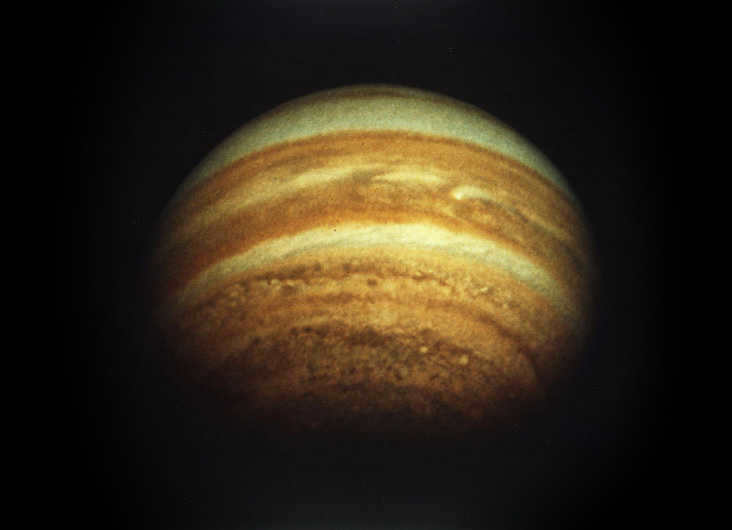
Picture
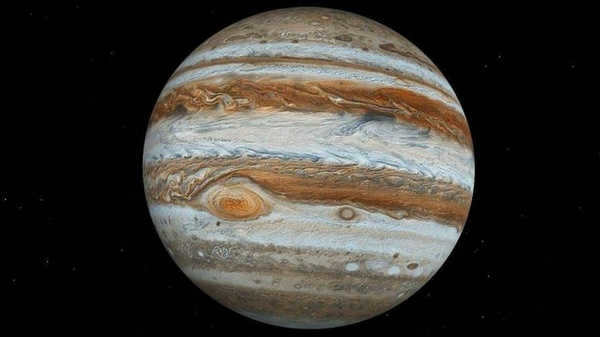
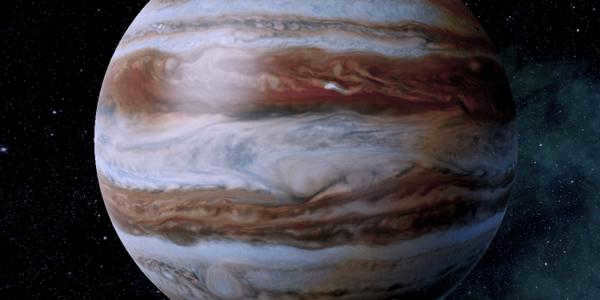
Comet Catcher
Without Jupiter’s presence, we wouldn’t be able to read this text at this moment. Jupiter’s immense gravitational force has been instrumental in capturing and diverting comets and asteroids that are on a collision course with the Sun. A notable example of this occurred in 1994 when Jupiter acted as a shield against a potential threat. The Shoemaker-Levy comet was obliterated by Jupiter’s gravity, much like a hammer striking a delicate pebble.
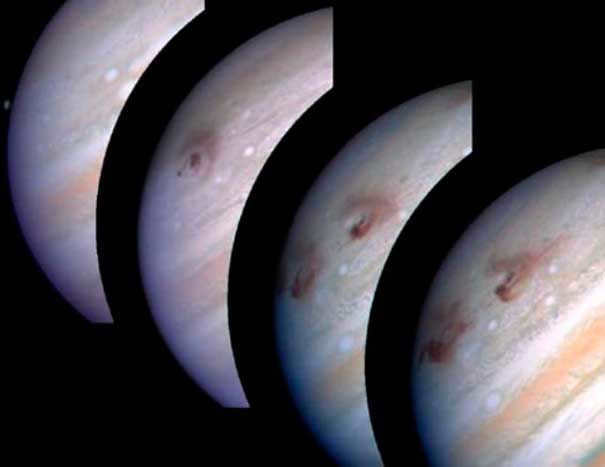
The impacts caused by the descent of the larger fragments surpassed the destructive force of a 100-megaton hydrogen bomb by a factor of 10,000. However, due to the nocturnal nature of the events, the phenomenon remained invisible to the human eye.
Even though humans have been aware of the existence of the planet for centuries, its exploration is an ongoing endeavor.
Various mythologies from different cultures contain numerous mentions of this celestial body. It is widely believed that the name of the planet was derived from the homage to the supreme deity of the heavens and the ancient Roman god of thunder.

There has been an increased interest in studying the planet Jupiter in recent years, with both telescopes and spacecraft being used for exploration. The Hubble telescope, AMS Pioneer 10 and 11, Voyageromi, Ulysses, Galileo, Cassini, and other probes have all been involved in this effort. In addition to studying the planet itself, satellite objects in the Jupiter system have also been a focus of research, resulting in the collection and analysis of numerous images, materials, and data. Despite the progress made, ongoing research and future missions are planned to further explore Jupiter and its satellites, with the hope of uncovering more answers about this fascinating planet.
Magnetic field and radiation belts
The magnetic field of Jupiter has been discovered to have a unique and flattened shape, resembling a disk.
Surrounding the planet is a magnetosphere, which is further influenced by a torus in its orbit.
When a circle rotates along an axis within the same plane, without intersecting, it forms a torus – a surface of rotation.
Remarkably, Jupiter possesses highly intense regions within its magnetosphere where it accumulates and maintains high-energy protons and electrons. These radiation belts contain levels of radiation that far surpass the lethal dose for humans.
Fascinating information about Jupiter
- Jupiter is the only celestial body in our solar system with its center of mass located outside of the Sun’s region, accounting for approximately 7% of the Sun’s mass.
- Among Jupiter’s unique features are its three faint and delicate rings that are interlinked. These rings consist of the main ring, the web, and the halo.
- Jupiter is also home to a collection of asteroids known as Trojan asteroids. These asteroids orbit the Sun in a similar fashion as the planet.
- Permanently present on Jupiter are its auroras, although the intensity of these auroras can vary.
- One of Jupiter’s enigmatic phenomena is the Great X-ray Spot, predominantly located at the planet’s poles, particularly the northern pole. This pulsating source of X-rays remains a mystery, as its origin is still unknown.
- By the way, the duels occur regularly. They take place every 13 months. And once a year, there is a major confrontation. During this period, Jupiter is located in the perihelion region of its orbit.
- There is a fascinating hypothesis suggesting that Jupiter could be considered a failed star due to its abundance of satellites.
Deadly radiation on Jupiter
Jupiter’s magnetic field acts as a deadly trap, attracting ions, protons, and plasma particles. These charged elements come from various sources, including solar winds, the Galilean moons, and volcanic emissions from Jupiter’s moon Io.
These microparticles are propelled at high speeds and create stunning auroras at the planet’s poles. While the auroras are a regular occurrence, their intensity can vary. In fact, Jupiter’s permanent auroras are hundreds of times brighter than the temporary ones seen on Earth.
However, there is a dark side to this beauty. The particles trapped in Jupiter’s magnetic field form radiation belts that pose a significant threat. The radiation dose within these belts is 25 times more lethal to the human body than what we experience on Earth. These conditions make life on Jupiter impossible, and its radiation is considered the most dangerous in the entire solar system.
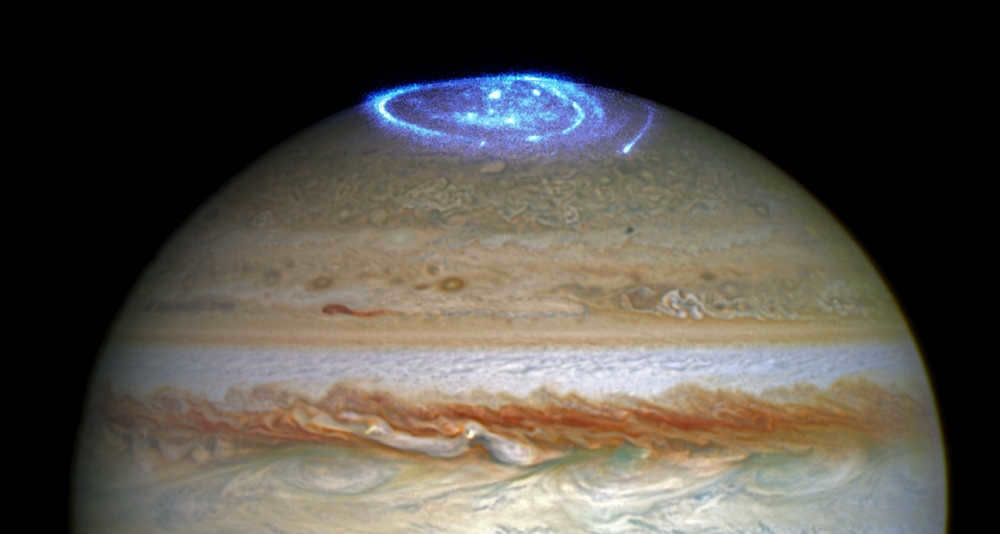
Jupiter’s Position in the Solar System
Visualization of Jupiter’s Surface
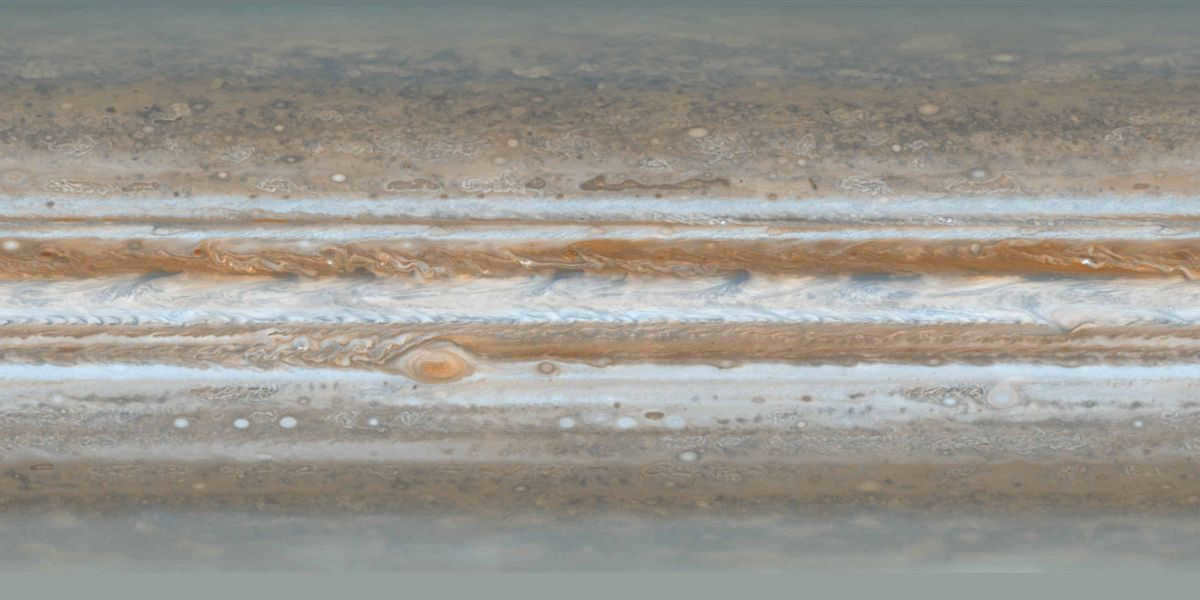

The Etymology of the Planet’s Name

The Roman deity Jupiter
Due to its prominent visibility in the celestial realm, Jupiter was bestowed with various epithets by ancient civilizations. Among the Romans, this colossal celestial body was revered as their god of the heavens and thunder. Even with the advent of Christianity, the enduring influence of ancient mythologies on the populace made their eradication impossible. The field of astronomy similarly bore witness to this phenomenon. Presently, numerous stars, planets, and galaxies continue to bear the names of these ancient deities, with Jupiter being no exception.
Fatal allure
Among all the celestial bodies in our solar system, Jupiter possesses the most potent magnetic field. The poles of this gas giant are distinguished by a magnetospheric intensity that surpasses Earth’s magnetic field by a factor of 20,000. Its magnetic influence stretches across millions of kilometers and even reaches the rings of Saturn.
The source of this magnetic force lies within Jupiter’s core, where metallic hydrogen is concentrated. The immense pressure and temperature at the heart of this colossal planet cause metallic hydrogen to transform into a liquid state, resulting in an ideal conductor of electricity.
Interestingly, the thickness of the metallic hydrogen layer in Jupiter varies within a range of approximately 44,000 kilometers. Within this layer, and due to Jupiter’s rapid rotation, powerful electric currents are generated, thus engendering the formation of the dominant magnetic field.
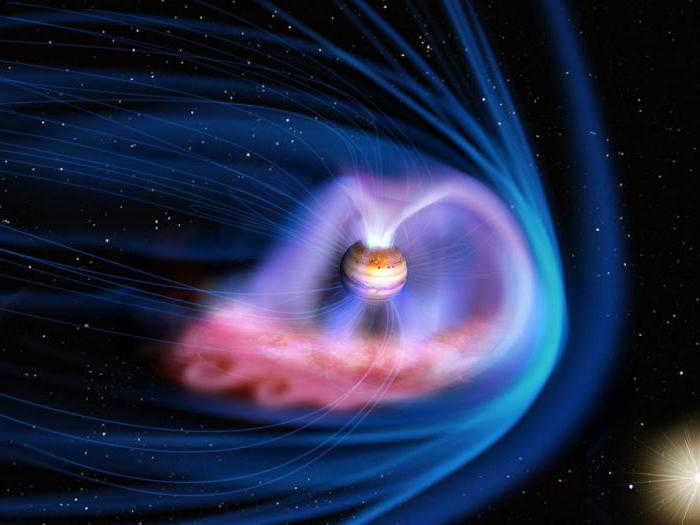
The magnetic field
Jupiter is the largest planet in our solar system. It is easily visible at night, with only Venus and the Moon shining brighter than it. Even ancient astronomers were familiar with this planet. It was named after the powerful ancient Roman god of thunder.
The mass of Jupiter is incredibly large. In addition to Jupiter, there are 7 other planets of various sizes in our solar system. However, Jupiter alone has a mass that is two and a half times greater than all the other planets combined. Earth, considered a small planet, is 318 times lighter than Jupiter.
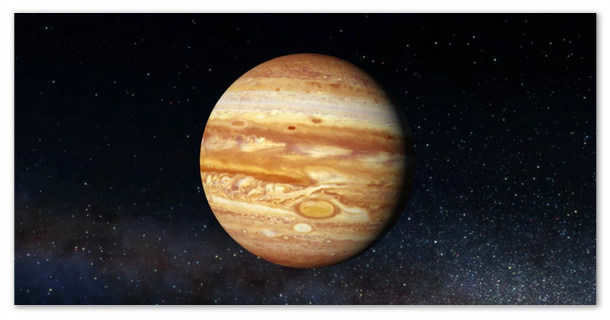
Location within the solar system
When it comes to its position relative to the Sun, Jupiter is classified as the fifth planet. It completes one orbit around the Sun in a span of 12 Earth years. Interestingly, Jupiter has a relatively short day, lasting only 10 hours, during which it manages to make a full rotation around its axis.
It’s important to note that the distance between Jupiter and Earth is not constant due to the non-circular nature of planetary orbits. These orbits have an elongated shape, causing the distance to fluctuate between half a million and nearly a million kilometers at different times.
This gas giant planet is primarily composed of hydrogen and helium, with small amounts of nitrogen, hydrogen sulfide, and ammonia present in its atmosphere. According to scientists, the planet lacks a solid surface and instead consists of a gaseous state, resembling a boiling ocean of liquid hydrogen. The intense pressure on Jupiter causes the hydrogen to become liquid, and combined with its extremely high temperatures, comparable to the surface of the Sun, reaching up to +6000 degrees Celsius, it makes it impossible for life to exist there. Interestingly, the clouds in Jupiter’s atmosphere have negative temperatures, reaching as low as -150°C, which is quite remarkable.
Giant Hurricanes on Jupiter and the Mystery of the Red Spot
Due to its rapid rotation, Jupiter experiences incredibly fast winds, with speeds reaching up to 600 kilometers per hour. As a result, this gas giant is constantly plagued by powerful hurricanes, massive thunderstorms, and stunning auroras.
One particular hurricane has become legendary, as it has been raging for nearly 350 years. In 1664, the renowned naturalist Robert Hooke caught sight of a “great red spot” through a simple telescope. For many years, scientists struggled to unravel the mystery surrounding this phenomenon. It was only in the twentieth century that they finally determined it to be a long-lived atmospheric vortex. Today, the red spot is twice the size of Earth, though a century ago it measured four times larger.
Aside from the major crimson spot in 1938, there were three additional ivory ovals observed – which are also cyclones. In 1988, a pair of these ovals amalgamated into a solitary vortex, and in 2000, a third ivory oval became part of the union. In 2005, this immense hurricane, comprised of three lesser ones, commenced a transformation in hue and became scarlet. It is now referred to as a diminutive crimson spot.
Satellites
Jupiter possesses a total of 67 moon satellites. It is possible to observe the four larger satellites using regular binoculars from Earth. The largest among them, Ganymede, has a size that is approximately half of Earth’s. Remarkably, Ganymede holds the title for being the largest satellite within the entire solar system.
Outlined below are the ten most substantial satellites orbiting Jupiter:
- Ganymede (measuring 5260 kilometers in size);
- Callisto (measuring 4820 km);
- Io (measuring 3,642 km);
- Europa (measuring 3122 km);
- Amalthea (measuring 250 km);
- Himalia (measuring 170 km);
- Thebes (measuring 116 km);
- Elara (measuring 86 km);
- Pasiphae (measuring 60 km);
- Carme (measuring 46 km);
- Lysithea (measuring 36 km).
The five smallest satellites have a size of approximately 1 km each.
As a planet is surrounded by numerous satellites and smaller celestial bodies, it is inevitable that collisions between them occur, leading to fragmentation. Consequently, these collisions result in the ejection of vast quantities of dust into the surrounding space.
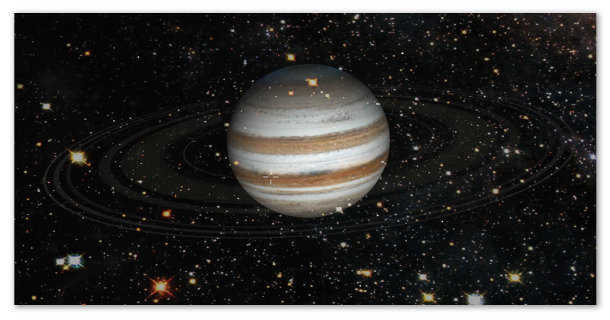

In addition, the massive planet attracts comets that also leave behind a significant amount of dust.
Due to the planet’s rotation, all of these dust clouds gradually shift towards the equator and transform into ring structures.
Similar to Saturn, Jupiter also possesses a planetary ring system. It consists of five distinct rings:
- The Halo ring is the closest to the planet and is the thickest, measuring 30 thousand kilometers in width.
- The Main ring is the most prominent and brightest among the rings, spanning 6,500 kilometers in width.
- The Amalthea’s Spider Ring, named for its transparent appearance, has the same mass as the Main ring but is comparatively thinner.
- The web ring of Thebes is the least bright and most see-through.
- Himalia’s ring is the most recent and thinnest. It formed in 2000 when one of the newly discovered satellites collided with Himalia, causing it to break apart into small fragments and dust.
The four nearest satellites: Adrastea, Thebes, Metida, and Amalthea – orbit within and around these rings. The rest of the satellites are positioned much further from the planet, behind the rings.
Exploration of Jupiter
The study of the enormous planet Jupiter started with the advancement of modern astronomy. To explore this celestial body, interplanetary vehicles such as Voyager, Pioneer, and Galileo were launched. Researchers are utilizing both orbital telescopes located on artificial satellites around Earth and telescopes on the ground to conduct their studies.
If you found this information helpful, please consider joining our VKontakte group. Additionally, we would appreciate it if you could click on one of the “like” buttons:
Category: Astronomy
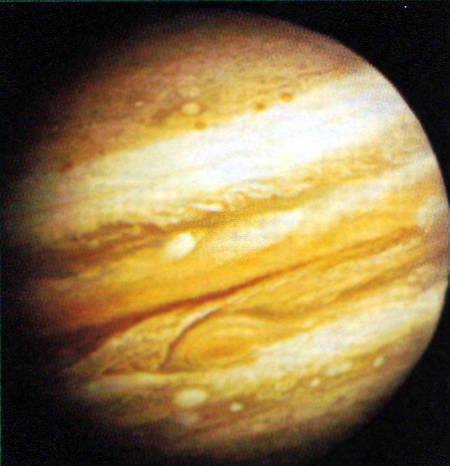
There are distinct dark and light stripes on the visible surface of Jupiter that run parallel to the equator. These stripes are known as belts and zones, with the largest one being the tropical belt. Over time, the color and width of these belts and zones can change. In the southern latitudes, there is a large oval feature called The Great Red Spot (BKP), which slowly moves in longitude and has a maximum size of 30-40 thousand kilometers. The solar constant on Jupiter is measured at 50 W/m 2 , and the solar illuminance is approximately 5000 lux. The bolometric spherical albedo is calculated to be 0.42 ±0.07. The average observed effective temperature on Jupiter is between 125-135 K, which is similar to the temperature of the outer cloud layers. This temperature is higher than the calculated equilibrium temperature of 105 K. Interestingly, there is no significant difference in temperature between the day and night sides of Jupiter.
The exploration of Jupiter’s space began with the American spacecraft Pioneer 10 and Pioneer 11, which flew close to the planet in 1973 and 1974. By analyzing the changes in their orbits, scientists were able to determine the degree of compression of the planet and calculate the harmonics of its gravitational potential up to the sixth order. These findings provide support for the hypothesis that Jupiter is composed of a liquid substance and is in a state of hydrostatic equilibrium throughout its various layers. In 1979, the Voyager 1 and Voyager 2 spacecraft made flybys of Jupiter, capturing and transmitting high-quality television images of the planet and its moons back to Earth. These missions also allowed for the study of Jupiter’s atmosphere, cloud layer, magnetic field, ionosphere, and magnetospheric plasma.
Jupiter’s Composition: A Unique Blend of Hydrogen and Helium
When it comes to Jupiter, its atmosphere and interior are dominated by two key elements: hydrogen and helium. Scientists believe that the proportion of these elements (by mass) at a particular level, where the pressure is about 100 kPa and the temperature hovers around 150-175 K, closely mirrors that of the Sun – specifically, a ratio of 3.4:1. However, what lies beneath the surface is even more intriguing.
Deep within Jupiter, there exists a boundary where molecular hydrogen transitions into metallic hydrogen. This shift occurs at a depth that is roughly 0.75-0.8 times the radius of Jupiter, corresponding to an intense pressure of approximately 300 GPa.
Based on current theories, scientists believe that the center of the planet is composed of a liquid core made up of metals and silicates. This core is surrounded by a shell of icy water and possibly ammonia. The central core has a radius that is less than 0.1 of Jupiter’s radius, and its mass accounts for approximately 3-4% of the entire planet’s mass. The temperature within the core reaches around 25,000K, while the pressure reaches approximately 8000 GPa. The model that best explains these observations is one that assumes an adiabatic temperature gradient throughout the planet’s interior.
Measurements taken from spacecraft have confirmed that there is a significant heat flow originating from within Jupiter, although it is smaller compared to observations made from the ground. This means that Jupiter emits roughly twice as much energy into space as it receives from the Sun, resulting in the effective temperature exceeding the equilibrium temperature. The exact mechanism behind the generation of this heat is not fully understood. Possible sources could include ongoing cooling, the planet warming up due to gravitational compression at a rate of approximately 1 meter per year, the continuous conversion of molecular hydrogen into metallic hydrogen, or the precipitation of helium from the hydrogen-helium solution and the subsequent migration of helium towards the planet’s core.
When discussing Jupiter’s atmosphere, it can be considered as a 1000-kilometer gas layer to some extent, as the planet lacks a surface that separates the solid shell from the gaseous one. The temperature of this gas layer is approximately (165 ±5) K when the pressure is 100 kPa. In terms of temperature variation, an adiabatic gradient can be used as a rough approximation. The lower atmosphere of Jupiter exhibits strong vertical movements and large-scale circulation. Its main components include hydrogen and helium, with traces of methane, ammonia, and water. The exact water content is not well known, with a difference of two orders of magnitude ranging from 10 -1 to 10 -3 %. The concentration of CH4 is approximately 0.06%, while NH3 is less than 0.02%. Both of these constituents contribute to the absorption bands observed in Jupiter’s spectrum. Other molecules present in the atmosphere include CO, PH3, GeH4, CH3D, HCN, C2H6, and C2H2. The reddish and yellow hues observed on Jupiter’s surface are believed to be caused by the presence of amorphous red phosphorus, hydrogen and ammonium polysulfides, sulfur, and possibly organic compounds generated by electrical discharges in the atmosphere.
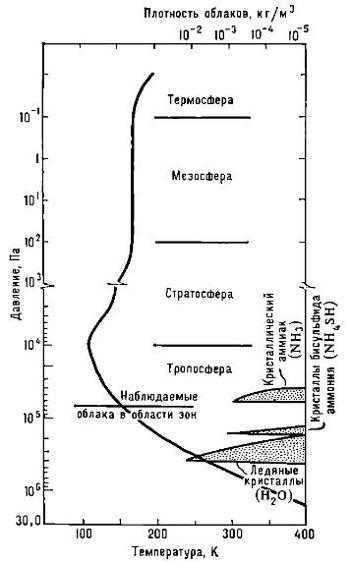
Reconstruction of the composition and arrangement of the atmosphere and cloud formation on Jupiter
Utilizing data from Pioneer-10, 11, Voyager-1, and 2 spacecraft, scientists have been able to gather valuable insights into the structure and characteristics of clouds in Jupiter’s atmosphere. Distinct belts and zones on the planet’s surface exhibit varying cloud heights. A computational model has been developed to represent the cloud cover, comprising of three primary layers. The upper layer (50-100 kPa pressure) is composed of crystalline ammonia, the intermediate layer consists of ammonium hydrosulfide NH4SH, and the lower layer (a few kPa pressure) is made up of water ice crystals.
The Amazing Red Spot
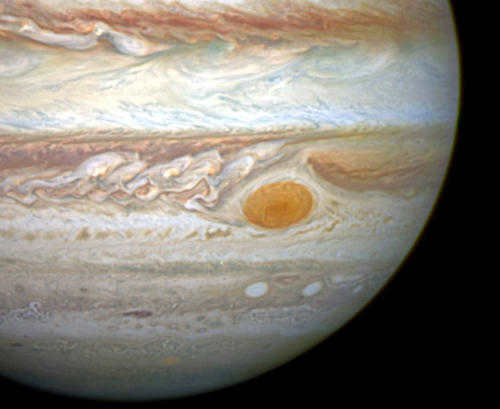
Temperature Variation on Jupiter
Based on radio measurements, the coldest temperature in the atmosphere of Jupiter (80-120 K) is observed at a level where the pressure is approximately 10 kPa, which occurs when spacecraft enter Jupiter’s disk. There is a temperature inversion region between the levels corresponding to pressures of 1 and 10 kPa, and at the 1 kPa level, the temperature rises to 130-170 K. These findings align well with temperature measurements conducted using infrared radiometers. Calculations indicate that Jupiter’s mesosphere, within the pressure range of 0.1-100 Pa, has a relatively constant temperature of around 180 K. In the thermosphere and exosphere, the temperature is similar to the average electron temperature of 800-1000 K. Additionally, thunderstorm activity has been observed in Jupiter’s atmosphere at the cloud level.
Ionosphere and magnetosphere
Jupiter has an ionosphere that stretches over 3,000 kilometers and contains approximately 10^11 particles per cubic meter. Fluctuations in electron density have been observed, with these irregularities being evenly distributed in the lower ionosphere. However, at higher altitudes, deviations from a uniform distribution occur due to the influence of Jupiter’s magnetic field.
Jupiter also possesses a magnetosphere that has an angular size of approximately 2 degrees when viewed from Earth. The magnetosphere extends 50-100 times the radius of Jupiter on the day side, depending on the variations in the solar wind. On the night side, Jupiter’s magnetic plume extends beyond Saturn’s orbit, reaching a distance of more than 5 astronomical units.
The magnetic field of Jupiter’s dipole has a strength of 318 A/m at the equator (at a pressure level of approximately 100 kPa). The magnetic axis is tilted relative to the planet’s rotation axis by approximately (10.2 ±0.6) degrees. At the poles, the field strength is measured at 1105 A/m (at the north pole) and 1063 A/m (at the south pole). While the magnetic field of Jupiter maintains its dipole nature up to a distance of about 15 radii of the planet, there are noticeable contributions from the quadrupole and octupole components. Additionally, charged particles captured by Jupiter’s magnetic field have a significant influence on the configuration of the field. These particles rotate along with the planet, resulting in the formation of a “magnetic disk” around Jupiter. In the outer regions of this disk, it is likely that magnetic field lines are not closed, and the disk itself is probably deflected at larger distances from the plane perpendicular to the planet’s rotation axis.
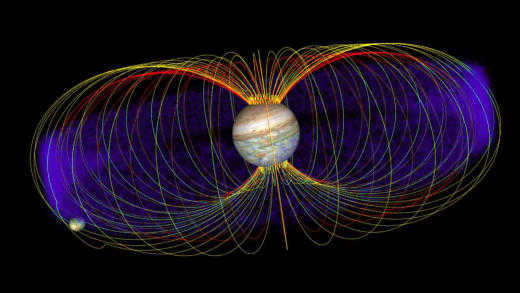
Jupiter’s magnetic field shares many similarities with Earth’s magnetic field, but on a much larger scale. The protons and electrons within Jupiter’s magnetic field create radiation belts, similar to those found around Earth. These belts are responsible for producing decimeter radiation, which is generated by the movement of trapped electrons within a toroidal region located 1.5-6 times the radius of Jupiter. These electrons have an energy level of approximately 10 MeV. Additionally, bursts of decameter radiation at 8 MHz are believed to be caused by plasma instabilities in Jupiter’s ionosphere. It is also worth noting that Jupiter emits radio waves in the meter range.
Jupiter’s magnetosphere, which is a miniature version of a pulsar, experiences a significant acceleration of electrons that travel to the orbit of Earth. These electrons have an energy range of 3-30 MeV. Both inside and outside the magnetosphere, the fluxes of accelerated electrons exhibit a ~10-hour periodicity, which aligns with Jupiter’s rotation period. This indicates that the observed variations are a result of the interaction between solar plasma and Jupiter’s magnetosphere.
The radiation emitted by Jupiter is incredibly intense, to the extent that the spacecraft “Galileo” received a radiation dose that is 25 times more lethal to humans while approaching the planet.
Satellites of Jupiter

Jupiter’s Galileo satellites consist of Europa, Ganymede, Io, and Callisto.
In 2017, there were a total of 69 satellites orbiting Jupiter (compared to 15 in 1983). The four largest satellites (Io, Europa, Ganymede, and Callisto) were first discovered by Galileo in 1610 and are commonly referred to as the Galilean satellites. Jupiter also has a group of asteroids, known as “Trojans,” which are located ahead and behind Jupiter in its orbit. These Trojans move in the libration points of Jupiter’s orbit. Additionally, Jupiter’s strong gravitational influence affects periodic comets that move in elongated orbits between the Sun and the outer regions of the solar system. Jupiter is also surrounded by a ring, which extends to a distance of approximately 55,000 km from the upper boundary of its clouds. This ring is estimated to be around 6,000 kilometers wide and 1 kilometer thick. It is composed of particles with low albedo, ranging in size from a few micrometers to a few meters.
After conducting flybys of spacecraft, scientists were able to determine the mass ratios of Jupiter’s Galilean satellites to the mass of Jupiter itself, as well as their respective diameters. Here are the findings:
Key Parameters of Jupiter’s Satellites
The densities of Jupiter’s satellites decrease as their distance from the planet increases. For example, Io has a density of 3530 kg/m 3, Europa has a density of 3030 kg/m 3, Ganymede has a density of 1930 kg/m 3, and Callisto has a density of 1790 kg/m 3. This variation in density is a result of the satellites’ internal structures. Io is primarily composed of rocky materials, while Europa is 20% rocky and 80% water ice. Ganymede is 40% rocky and 60% water ice, and Callisto is almost entirely composed of water ice.
Io is known for its strong volcanic activity. This volcanic activity is believed to be caused by tidal energy dissipation resulting from the satellites’ interactions with Jupiter’s gravitational field. Volcanoes on Io emit powerful sulfur emissions, reaching altitudes of up to 250 km at speeds of 1 km/s. The surface of Io is covered by a thick layer of sulfur and sulfur dioxide, giving it a red-orange color.
Europa’s surface is icy and flat, with numerous wide cracks. Ganymede and Callisto also have icy surfaces, with extensive sediments and outcrops of dark material. These surfaces are heavily cratered, particularly Callisto. Tectonic activity in the past is believed to have played a significant role in shaping the observed structures on Ganymede and Callisto.
Io possesses its own atmosphere and ionosphere Io has a unique atmosphere and ionosphere, primarily composed of sulphur and sodium ions. As it orbits, a gas torus is formed. The ionosphere is believed to be generated by the impact ionization of atmospheric atoms that become charged due to particles from Jupiter’s magnetosphere. In turn, the satellites themselves create a noticeable disturbance in the magnetosphere: Io’s ionosphere causes modulation in Jupiter’s radio emissions. In the polar regions, strong electric fields are established between Io’s torus and Jupiter’s magnetosphere, resulting in the acceleration of charged particles and their expulsion into Jupiter’s atmosphere. This process is accompanied by the appearance of polar lights and powerful hydrogen emissions.





